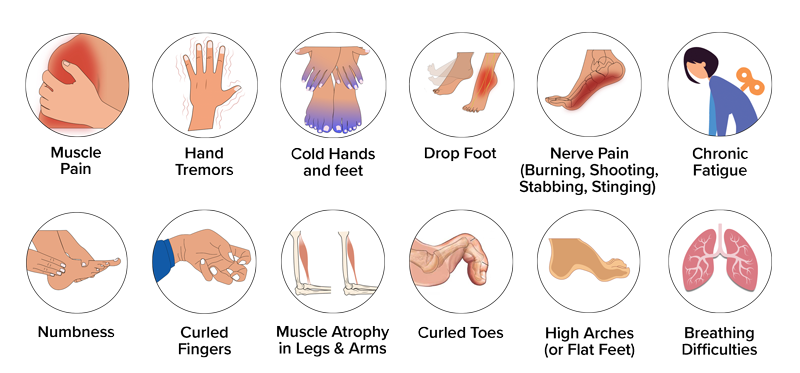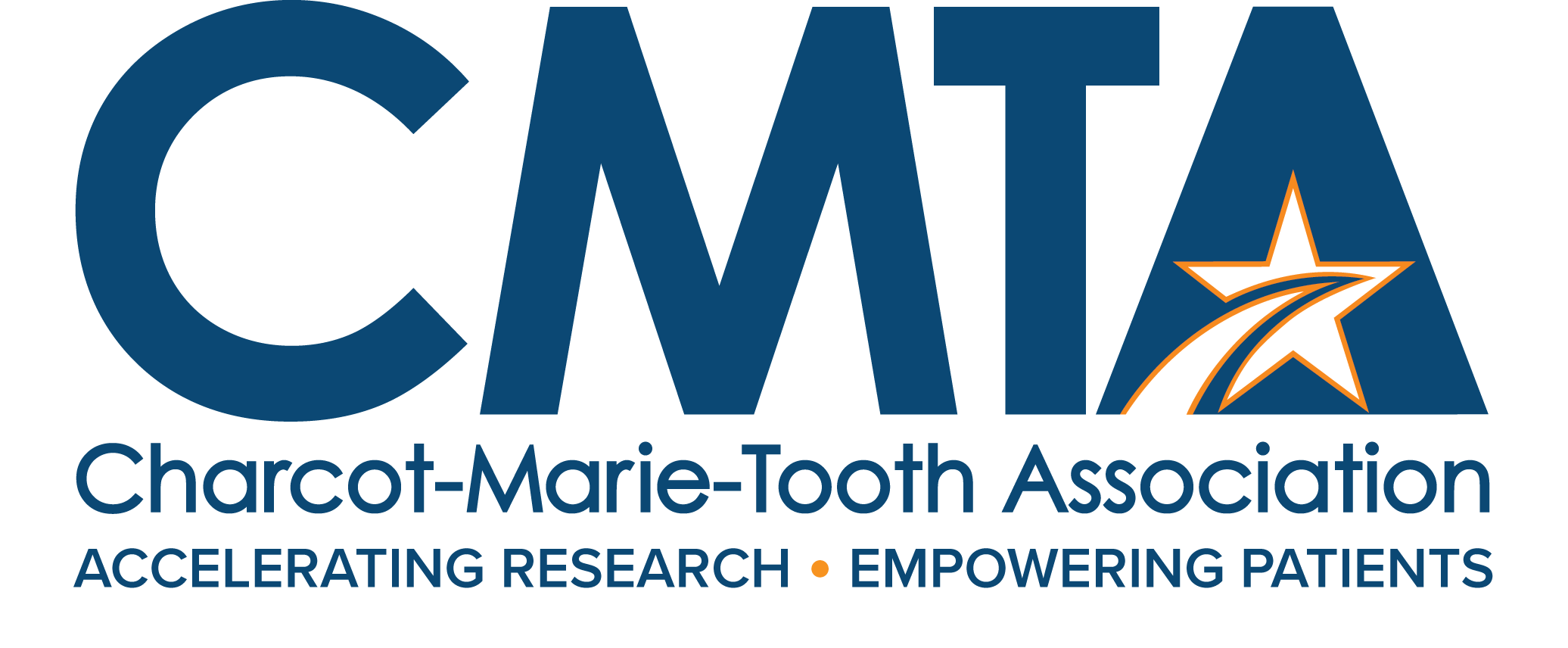
What is Charcot-Marie-Tooth disease?
Charcot-Marie-Tooth (CMT) is a disease of the peripheral nerves that control muscles that can cause progressive loss of function and sensation in the hands, arms, legs, and feet. CMT is a form of inherited peripheral neuropathy.
How is CMT pronounced?
One common question asked is how is Charcot-Marie-Tooth pronounced. See below for the pronunciation of Charcot-Marie-Tooth disease.
(shar-ko¯’ mä-re´ tooth)
Where did the name CMT come from?
CMT is the acronym for Charcot-Marie-Tooth disease, named after the three physicians who first described it: Drs. Jean-Martin Charcot and Pierre Marie (both from France) and Howard Henry Tooth (of the United Kingdom).
How many people have CMT?
CMT affects 133,000 people in the United States and roughly 3 million worldwide.
Who gets CMT?
CMT can affect anyone regardless of race, gender, ethnicity, etc.
Is CMT genetic?
CMT is the most commonly inherited peripheral neuropathy. CMT can be passed on from one generation to the next. It can also occur as a new or spontaneous (de novo) mutation. Learn about CMT inheritance patterns.
How many gene mutations cause CMT?
Scientists have identified over 100 different gene mutations causing CMT. Most people (90%) have one of four types of CMT: CMT 1A (PMP 22); CMT 1B (MPZ); CMT 2A (MFN2) and CMT 1X (GJB1).
How many types of CMT are there?
There are three main types of CMT – demyelinating (types 1 & 4), axonal (type 2), and intermediate.
Learn more about CMT Types and Subtypes
Is CMT progressive?
CMT is slowly progressive, causing loss of normal function and/or sensation in the lower legs/feet and hands/arms.
What are the symptoms of CMT peripheral neuropathy?

- First signs of CMT peripheral neuropathy may include toe-walking, frequent tripping, ankle sprains, clumsiness, and “burning” or pins-and-needles sensations in the feet and/or hands. Children with CMT may fall more frequently and be delayed in reaching some of the standard childhood physical milestones.
- Structural foot deformities such as high arches and hammertoes (curled toes) are common, but some people have flat feet and straight toes. Later in the disease process, contractures may develop in the fingers and hands.
- Foot drop (inability to lift foot at ankle), poor balance, and problems walking may develop as muscles atrophy in the feet and legs, and some people may have hip dysplasia.
- Difficulty with tasks involving manual dexterity, such as writing, grasping or picking up small object or manipulating zippers and buttons can develop as atrophy in the hands sets in and progresses.
- Abnormal sensation, loss of ability to feel light touch, the overall sense of touch, and the ability to perceive temperature change can become diminished, or even lost, in CMT. The loss of the ability to sense where one’s body is in space (proprioception) is also common, and many people experience musculoskeletal or neuropathic pain.
- Poor tolerance for cool, cold and/or hot temperatures is typical. Many people have chronically cold hands and feet. Additional symptoms may include flexed fingers, contractures, tremor, knee and/or hip problems, muscle cramps, muscle spasms, thenar muscle atrophy (loss of muscle mass between the thumb and forefinger), loss of overall hand strength, absent or reduced reflexes, chronic fatigue, obstructive sleep apnea, poor circulation, scoliosis, kyphosis, hip dysplasia.
- Rare symptoms include breathing difficulties caused by respiratory muscle weakness, swallowing or speaking difficulties, neurogenic bladder, hearing loss, optic neuropathy and vocal cord paralysis.
- The psychological impact of having CMT can’t be ignored, leading to irritability, depression, anxiety, feelings of hopelessness and guilt.
If you are having suicidal thoughts, immediately call your local suicide hotline or the National Suicide Prevention Lifeline: 1-800-273-TALK (1-800-273-8255), or seek help right away at a local emergency room.
How is CMT diagnosed?
A CMT diagnosis involves clinical evaluation of muscle function and atrophy, testing of sensory responses, and electromyographic and nerve conduction studies. Many types of CMT can also be diagnosed by genetic testing.
Learn more about the CMT Diagnosis Process
How is CMT different from Muscular Dystrophy?
CMT is a disease of the peripheral nerves that control muscles. Muscular dystrophy is a disease of the muscles themselves.
Is there a Treatment for CMT?
Although there is no drug treatment for CMT, physical therapy and moderate activity (but not overexertion) can help maintain muscle strength, endurance and flexibility. Mechanical supports like AFOs (ankle-foot orthoses) and custom-made shoes can improve gait and balance. When medically indicated, orthopedic surgery can correct deformity and help maintain mobility and function. Occupational therapy and adaptive devices can help people perform activities of daily living.
Is there a cure for CMT?
CMT is currently incurable, but not usually fatal, though it is severely disabling in a small proportion of cases.
Any medications people with CMT should avoid?
Some medications are neurotoxic to all humans. Some neurotoxic medications pose a greater risk to people living with Charcot-Marie-Tooth disease. Visit this page for more information about potentially neurotoxic medications. Before taking any medication or changing medications, be sure your physician is fully aware of your medical condition and discuss any possible side effects they may have on CMT. Have a drug/medication question? Email us at info@cmtausa.org.
Where Can I Get Help?
Founded in 1983, the Charcot-Marie-Tooth Association (CMTA) is a 501(c)(3) nonprofit organization whose mission is to support the development of drug therapies to treat CMT, to improve the quality of life for people with CMT, and, ultimately, to find a cure. Our vision is a world without CMT. The CMTA fulfills its mission with a wide variety of member services. Numerous publications are available, including the long-running CMTA Report and CMTeen, an online magazine by, for and about teenagers with CMT. Branches provide members education and support while CMTA Summits offer them the chance to get firsthand information from the best clinicians and researchers in the world. Those clinicians and researchers can also be found at CMTA Centers of Excellence, where people with CMT are examined and treated in multidisciplinary clinics while helping the CMTA systematically gather information for use in clinical trials and other CMT research.
Find a CMT Center of Excellence

The CMTA is aggressively pursuing treatments and a cure for all types of CMT. Since launching the Strategy to Accelerate Research (STAR) in 2008, the CMTA has been working with preeminent researchers, clinicians, patients and institutions in the global inherited neuropathy community to capitalize on breakthroughs in genetics.
Unlike other neuromuscular diseases, the genetic causes of CMT are known. In fact, more than 90 specific genes that cause the disease have been identified. More importantly, the fact that most of these genetic mutations can be replicated in laboratory models and grown as tissue cultures has opened an extraordinary window of opportunity to develop treatments and cures using the latest pharmaceutical, biotech, and gene therapy technologies.
“STAR is the most important initiative ever undertaken by the Charcot-Marie-Tooth Association,” according to Michael E. Shy, MD, Co-Chair of the Clinical Expert Board. “In addition to developing specific therapies for CMT patients, the translational science employed in the research could have major implications for the treatment of a host of related genetic disorders.”
The CMTA has made unprecedented progress toward therapies for virtually almost all types of CMT. Since the inception of STAR, the CMTA has financed more than 100 projects and committed over $23.5 million in research. Thanks to support from our donors, STAR continues to gain momentum and the promise of breakthroughs is imminent.










